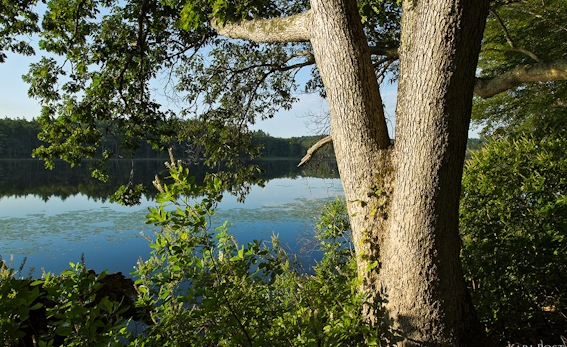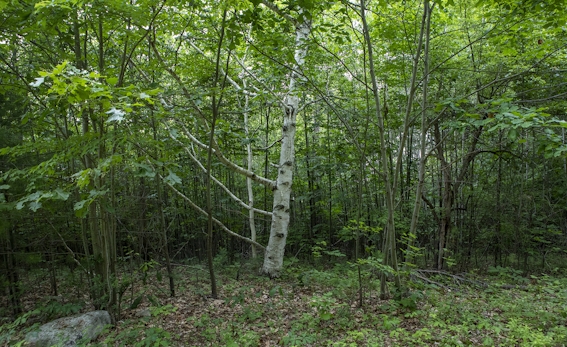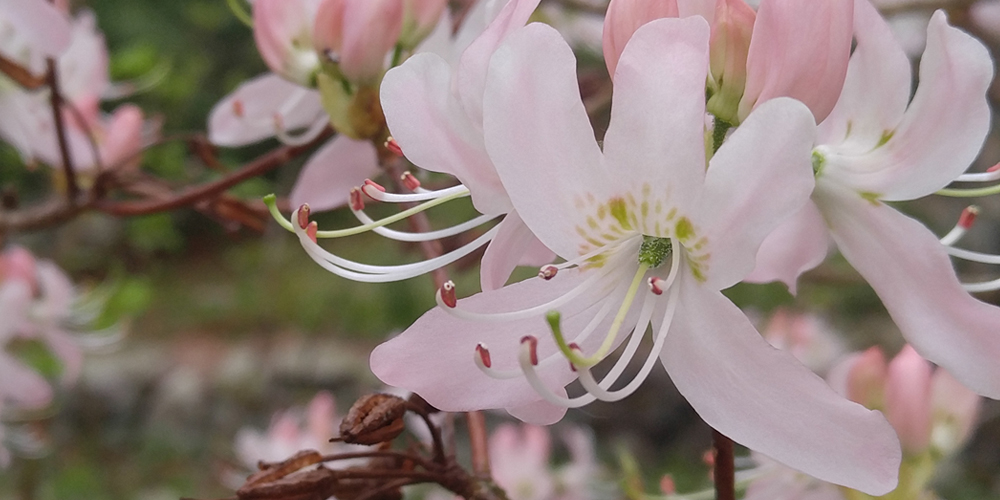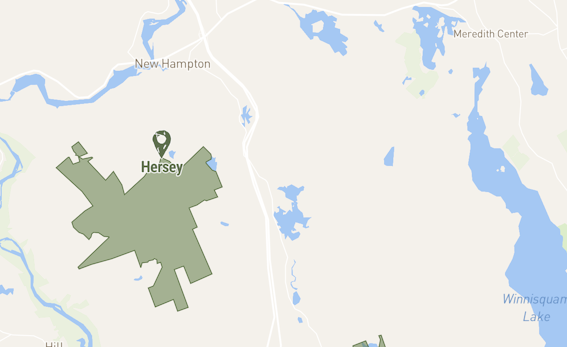
If you enjoy sunset views of distant mountains, sitting by a peaceful lakeside, and woodland strolls, look no further than Prouty Woods Community Forest, home to the New England Forestry Foundation headquarters.
Prouty Woods is a truly unique and significant tract of woodland within minutes of Route 495. The property includes 1,600 feet of frontage on Long Lake, and the summit of its Wilderness Hill provides expansive views to the west and north, including of Mount Monadnock. Prouty’s combination of forest, open fields, and riparian zones provides much-needed habitat for a variety of species. Walking trails open to the public, maintained by the Littleton Conversation Trust, connect to a town-wide system of trails.
NEFF conserves its Community Forests through ownership, and they are open daily, free to visit, and offer outdoor recreation opportunities. Unlike NEFF’s Community Forests, land protected by NEFF conservation easements—a legal tool—aren’t open to visitors unless their owners explicitly state so, because many belong to private individuals.
NEFF uses easements to conserve land owned by others. When a landowner grants NEFF an easement, it means they have permanently donated or sold to NEFF the landowner’s right to develop their own property, while the landowner otherwise retains ownership of their land; NEFF ensures the easements’ terms are met and enforced.

NEFF purchased this property from the Prouty family in fall 2003 to establish an Exemplary Forestry demonstration site. The main house serves as headquarters for New England Forestry Foundation, while the open fields near the house host an experimental chestnut plantation managed by the American Chestnut Foundation, and the property’s barn hosts the Littleton Community Farm.
As days lengthen and trees thaw out, sap begins to rise within them. The sap causes leaf buds to swell, and eventually the buds break open to release small spring leaves and, in many cases, blossoms. Meanwhile on the forest floor, a wide variety of smaller plants raise their leaves and flowers in order to capture some unfiltered sunlight before the trees are fully leafed out. Ferns unfurl their well-named fiddleheads that eventually become full-fledged leaves.
Prouty experiences these broad ecosystem changes like any other woodland, but visitors should also look for the property’s seasonal specialties. Breeding Barred Owls return to Prouty year after year, and can be regularly heard just after sunset in the spring. The large white blooms of the Flowering Dogwood, a small sub-canopy tree that flowers conspicuously in mid-spring, can be found all over the grounds, typically in early May.
Whether you are a first-time visitor or a Prouty regular, we hope the following self-guided tour will help you enjoy Prouty Woods on future walks and learn more about how this unique woodland changes as the weather warms.

Frank Lowenstein
Visit Prouty Woods Community Forest on our interactive map to locate the trailhead and download a PDF trail map. Maps of Prouty Woods are also available at the entryway kiosk.
Visitors to Prouty Woods can park in front of NEFF’s barn on Wilderness Road in Littleton.
As you walk up the road past the green gate, you will pass three areas of interest. Through the trees on the left you will first see two structures built by students from Harvard’s Graduate School of Design to test the thermal performance of different species of wood in an effort to change the way the construction industry thinks about and uses wood.
As you continue up the trail, look to the right to see an experimental chestnut plantation managed by the American Chestnut Foundation; a little further in, you will see the site of the Littleton Community Farm, an organic farm run using a Community Supported Agriculture (CSA) model.
Keep an eye out for tree identification signs! These postcard-sized signs provide information on the trees that you will find in Prouty Woods, from towering Eastern White Pines to Flowering Dogwood trees. This is a great time of year to learn about and observe trees: almost all of them, including evergreens like the white pine, flower and set seed in spring. Many flower just before the growth of new leaves begins.
If you are hoping to see Long Lake and take a substantial hike, the Loop Trail is the perfect option. Take the first trail branch to the right after the farm fields, about a quarter mile from the parking area, and head down to the lake. As you walk, keep an eye (and an ear) out for a wide array of songbirds and waterfowl. In early May, when the leaves are just beginning to fill out, many species of migrating warblers pass through Prouty Woods and feed on insects. While you might not see them, there is a good chance you will hear the flute-like call of the Hermit Thrush, particularly in the later afternoon or dusk.
Just before you reach Long Lake, you will pass a Sugar Maple planted in honor of a longtime friend, past NEFF executive director John T. Hemenway. Sugar Maples produce clusters of green flowers in early spring, and when pollinated, the flowers become winged seed capsules.
A popular destination for fisherman (Massachusetts Fishing License required), Long Lake is home to Largemouth Bass, pickerel, Bluegill, and Yellow Perch. To the right of the observation bench, you will often see a Great Blue Heron stalking the shallow water for its next meal. Walking along the lakeshore toward the northeast from the observation bench, you may see dabbling ducks, as well as the occasional migrating loon and other waterfowl and songbirds. The Loop Trail continues along the lakeshore to the northeast, and then turns steeply to the left to climb over a shoulder of Wilderness Hill before descending again to rejoin the road. While climbing from the lake, keep your eyes open for a carpet of small, white Canada Mayflower blossoms.
The Summit Trail is a worthy detour for visitors hiking the Long Trail. With forty-mile views from the top of Wilderness Hill, this is a wonderful place to catch the sunset before the property closes at dusk, particularly now that days are growing longer. Looking to the northwest on a clear day, you can see Mount Monadnock in the distance, and in the spring, you can see a mosaic of different shades of green as leaves fill out across the landscape. The Summit Trail turns left from the Loop Trail at the height of land. You can also reach the summit by continuing straight on the road and skipping the Loop Trail.
In early spring, visitors to Prouty Woods have a chance to see and hear one of New England’s most spectacular (and peculiar) performances—the American Woodcock’s courtship display, often referred to as the “sky dance.” Woodcocks, also called timberdoodles, are shaped like a very small football, colored a mottled brown with awkwardly long beaks and stout legs.
Male woodcocks perform a courtship display in the spring that involves propelling themselves upward in a spiraling flight pattern. As they climb, they chirp, and their wings produce an otherworldly twittering sound. When they reach the top of their flight, up to 350 feet in the air, they plummet back to the ground in an erratic zigzag pattern as they continue emitting sounds from specialized wing feathers. Once on the ground, these small birds perform a bobbing dance as they walk and let out a periodic peent call.
To have a chance to see this mesmerizing display, listen for the distinct peent call on top of Wilderness Hill and in the farm fields near the start of the hike, either in the early morning or as the sun is setting. If you hear the call, wait quietly, and you might be able to witness the woodcock’s courtship display.
Want to head out and explore? Our interactive map of all NEFF Community Forests will help you get on your way. It provides property-specific trail maps you can download, as well information about each forest’s history, recreational opportunities, natural features, and more.
